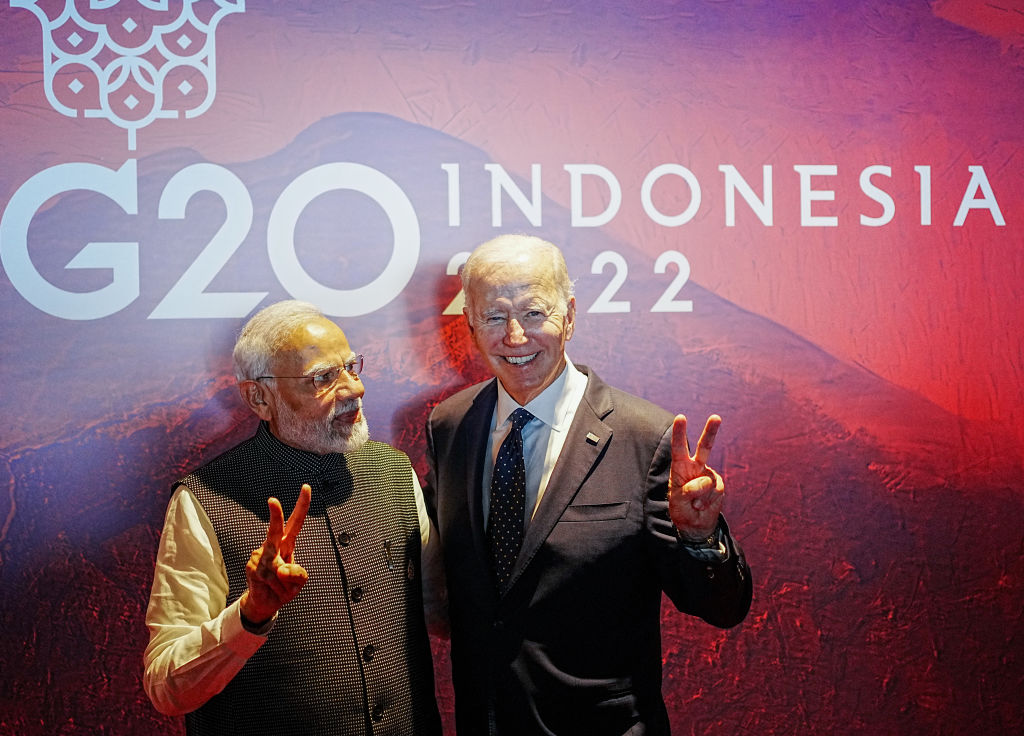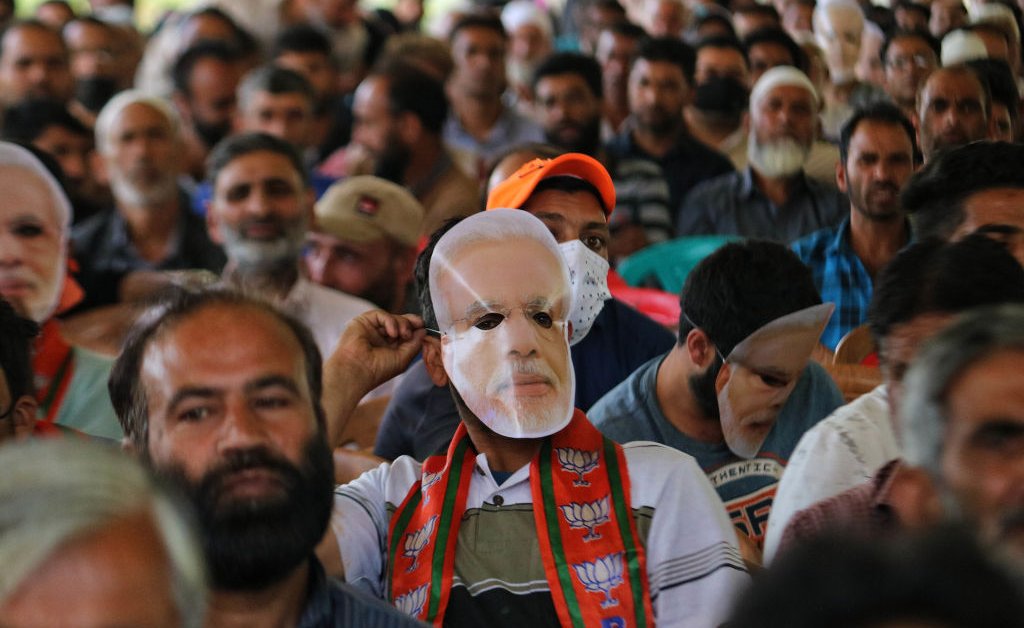Indos
PDF THINK TANK: ANALYST

- Joined
- Jul 25, 2013
- Messages
- 23,466
- Reaction score
- 24
- Country
- Location
India’s Worsening Democracy Makes It an Unreliable Ally

A supporter of the rightwing Bharatiya Janata Party (BJP) wears a mask of Indian Prime Minister Narendra Modi as he listens to speeches of the party leaders during a public rally in Srinagar. Thousands of BJP supporters attended the rally to mark the 9th anniversary of Prime Minister Narendra Modi's government.
Firdous Nazir-Future Publishing
BY SALIL TRIPATHI
JUNE 20, 2023 3:02 PM EDT
Tripathi is an Indian-born writer based in New York who has been a foreign correspondent in Singapore and Hong Kong and the author of three works of non-fiction. He is a member of the board of PEN International.
India’s Prime Minister Narendra Modi arrives in the United States on 21 June, which is World Yoga Day. Asserting India’s soft power, he will participate in a yoga demonstration at the United Nations headquarters in New York, while the Biden administration will be laying out the red carpet in Washington. On the sidelines of the G-7 summit in Japan last month, Indian media claimed President Joe Biden reportedly quipped to Modi that that his staff was struggling to cope with the demand surge for invitations to the State dinner he will host. Modi will also address a joint session of the Congress.
India’s pliant media is projecting the visit as unprecedented. Don’t rule out stories that count the number of times Congress members will applaud Modi, whether they stand up when they clap, measure the duration of the applause, and compare it with responses to similar addresses by former Indian leaders, hoping that Modi will set a record. For Modi likes adulation and believes in superlatives, and the bulk of the Indian media today aims to please him.
World leaders visit Washington all the time, but the hyper-nationalist Indian media sees American eagerness in welcoming Modi as a sign of India’s arrival on the international stage. The drum roll began in April, when commerce secretary Gina Raimondo gushed over Modi, anointing him as the world’s most popular leader, calling him “unbelievable” and “visionary.” The White House called India “a vibrant democracy.”
To be sure, India has arrived. The U.S. wants closer, stronger, and more meaningful relationship with India as a destination of investments, as a strategic ally, and as a bulwark against the rise of China. India is now the world’s most populous country. As it regularly holds elections, India is called the world’s largest democracy, although most indices that measure human rights or democracy show the precipitous decline in India’s record on both counts in the nine years Modi has been in power. Depending on how you measure economies, India is now the world’s fifth-largest—according to the World Economic Forum, it overtook its former ruler, the U.K., last year. While some international economists are skeptical over India’s public statistics, its chief economic adviser claimed in March that India’s economy grew 7.2% last year. It remains among the top ten destinations for foreign direct investment in the world.
No doubt India is a military power, and it is part of the Quad, a diplomatic alliance including Australia, Japan, and the United States, ostensibly intended to spread stability and prosperity in Asia-Pacific, but really a thinly-veiled alliance to rival China. Surely India is an ally of western democracies?
Not so fast. India unequivocally defended anti-colonial struggles until the end of the Cold War (it was one of the earliest countries to impose sanctions on apartheid South Africa, and supported Palestine and many African liberation movements). But it has dragged its feet in supporting democracies since. The generals who annulled elections in Myanmar consider India a steadfast friend. It has issued only tepid, pious platitudes for peace in response to Russia’s illegal war in Ukraine. Its trade with Russia has not stopped, and it is accused of selling Russian oil in international markets undermining sanctions. It is wary of China, but only with regard to its disputed border; it has abstained U.N. resolutions on the treatment of Uyghurs and is unlikely to say anything meaningful if China invades Taiwan.

Narendra Modi, Prime Minister of India, and Joe Biden show the peace sign with their hands at the G20 summit after the second working session. The group of G20, the strongest industrialized nations and emerging economies, meets for two days on the Indonesian island of Bali.
Kay Nietfeld/dpa
India’s interpretation of its own interests are therefore not aligned with western interests, and if its positions align with certain western positions, those have less to do with any perception of shared values, and more with defending its own perspective. Even if India’s non-alignment was never consistent, and John Foster Dulles in fact called it immoral, India saw it as a practical response in a polarized world. And the Modi administration’s differences with earlier Indian governments are only a matter of degree, and not of kind.
Western wooing of India is real. There is the roadmap of defense collaboration with the U.S., the proposed submarine deal being negotiated with Germany, and France has invited Modi as a guest of honor on Bastille Day this July. These measures suggest a qualitatively different relationship, for India wants to diversify its defense procurement, which is still overwhelmingly reliant on Russian weapon systems. But the ties with Russia are historic, and China is a formidable neighbor which occupies vast stretches of territory India considers its own, and Chinese incursions have only increased in recent years. And yet, other than cosmetic steps like banning Tik Tok, India has not retaliated. Bilateral trade has grown to $136 billion (an 8% increase over the previous year) and its trade deficit with China has widened to $100 billion. While India would love to attract investors who look for alternate destinations other than China as part of their de-risking strategies, other countries in Asia are also looking to attract the same investments.
Realpolitik apart, the U.S. does speak of building ties based on values, such as democracy and human rights. First, India has always been a flawed democracy, but its human rights record has worsened significantly during Modi’s tenure. Researchers Suchitra Vijayan and Francesca Recchia have identified about 250 non-violent political prisoners who were put in jail without being formally charged or tried between May 2014, when Modi came to power, until July 2022, in their forthcoming book, How Long Can The Moon Be Caged?. The detained prisoners include lawyers, writers, human rights activists, and other socially-conscious dissidents. According to watchdog Access Now, India leads the world in network shutdowns, and as western tech companies have learned, India browbeats telecom and social media companies to take down content and threatens them with police action if they don’t comply.
The treatment of Muslims, who form 14% of India’s population, has worsened. A 2019 report by Human Rights Watch documented 44 murders (36 of them being Muslim) by lynch mobs who killed people they suspected of possessing beef, consuming it, or trading cows. Muslims find it hard to buy or rent property, are denied permission to build mosques in some cases, and prevented from praying in public. Vigilantes prevent Muslims from praying at home. Female Muslim students in one state were banned from wearing head-scarves. A senior politician from Modi’s Bharatiya Janata Party had welcomed convicted cow protectors with garlands. BJP-ruled states have passed laws to make it harder for inter-faith marriages from taking place. Right wing Hindus celebrated the early release of 11 men who were convicted of having raped a Muslim woman and murdered some of her family members during the massacres of 2002. Those incidents occurred when Modi was Gujarat’s chief minister and had failed to stop Hindu violence against Muslims. Modi was then barred from entry into the U.S. or the E.U. until India’s Supreme Court said Modi did not have a case to answer. A recent BBC film which blamed Modi for complicity, is banned in India.
Organizations that measure democracies have concluded that India’s democratic record has worsened. Freedom House has down-graded India to ‘partly-free’ status. India has fallen from 27 in 2014 to 46 in 2022, as per the Economist Intelligence Unit’s democracy index. The V-Dem project of the University of Gothenburg in Sweden has relegated India to “electoral autocracy.” The Civicus Monitor calls India’s civil society environment to be “repressed.” The Pew Research Center survey shows India’s social hostility score has worsened. And the World Press Freedom Index of Reporters Without Borders places India at 161, a historic low, down from 150, of the 180 countries it surveys. In the global impunity index of the Committee to Protect Journalists, India ranks 11th, with 20 unsolved murders of journalists.
More broadly, India’s rank in the U.N.’s Human Development Index has fallen slightly, from 130 the year Modi took office to 132, the International Food Policy Research Institute’s world hunger index shows India ranked at 107 out of 121 surveyed countries. the World Economic Forum’s gender gap index shows India ranked 135th of the 146 surveyed countries. Thomson Reuters Foundation calls India the world’s most dangerous country for women. Unsurprisingly, Cato Institute, which measures human freedom, downgraded India between 2015 and 2022 from 75 to 112.
These organizations are drawn from different countries, use different methodologies, and are not ideologically aligned. Yet, they present a consistent image of a country where freedoms are under peril. No doubt, such rankings can be arbitrary and subjective, and there may indeed be some methodological problems. For its part, India disputes many such findings.
This is hardly a report card any government should be proud of. But while such report cards annoy Modi, and his feisty foreign minister Dr S Jaishankar dismisses them pithily, Modi realizes two things: these organizations do not matter in India, and western governments note these concerns and privately might even agree, but publicly they are not about to challenge India. And so he goes on, his party members whip up religious passions to divert attention and he organizes picture-perfect spectacles. By raising the toast for Modi this week, the U.S. is helping him write the script of his re-election campaign and providing him excellent visual footage, which Modi will use to silence critics back home as his party prepares the script for the elections in 2024.

India’s Worsening Democracy Makes It an Unreliable Ally
India’s interests are not aligned with Western interests







